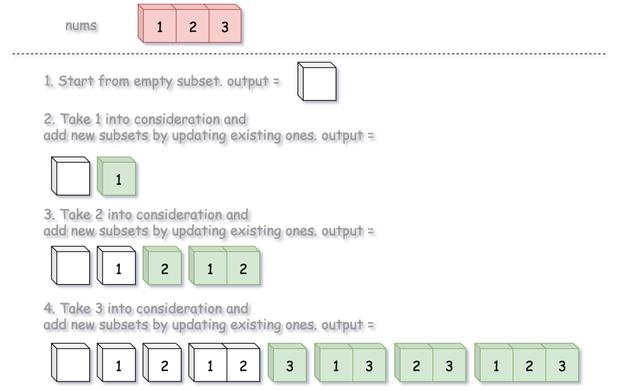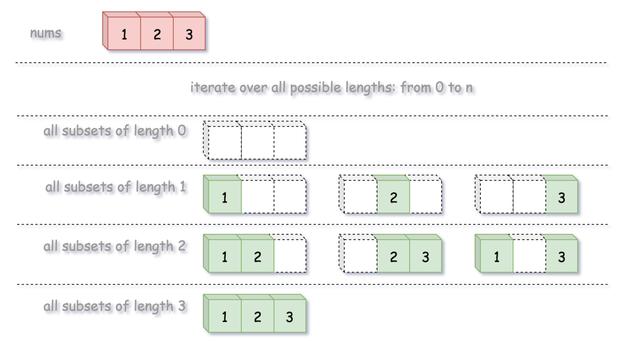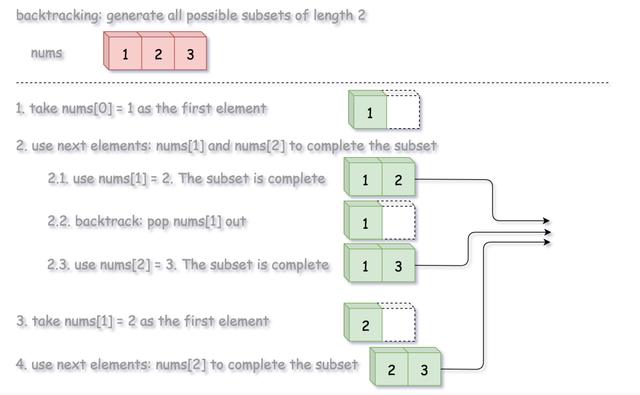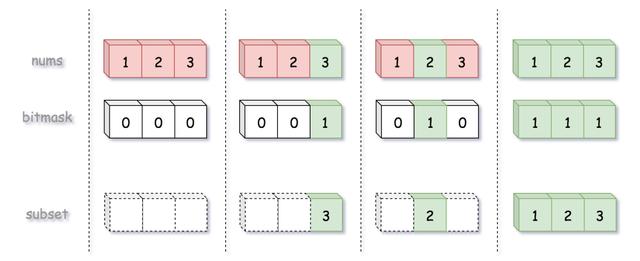
力扣 78. 子集 (点击查看题目)
题目描述
给定一组 不含重复元素 的整数数组 nums,返回该数组所有可能的子集(幂集)。
说明:解集不能包含重复的子集。
示例:
输入: nums = [1,2,3]输出:[ [3], [1], [2], [1,2,3], [1,3], [2,3], [1,2], []]解决方案
观察全排列 / 组合 / 子集问题,它们比较相似,且可以使用一些通用策略解决。
首先,它们的解空间非常大:
- 全排列:N!
- 组合:N!
- 子集:2^N,每个元素都可能存在或不存在。
在它们的指数级解法中,要确保生成的结果 完整 且 无冗余,有三种常用的方法:
- 递归
- 回溯
- 基于二进制位掩码和对应位掩码之间的映射字典生成排列 / 组合 / 子集
相比前两种方法,第三种方法将每种情况都简化为二进制数,易于实现和验证。
此外,第三种方法具有最优的时间复杂度,可以生成按照字典顺序的输出结果。
方法一:递归
思路
开始假设输出子集为空,每一步都向子集添加新的整数,并生成新的子集。

Python 实现(可在电脑端查看代码)
class Solution: def subsets(self, nums: List[int]) -> List[List[int]]: n = len(nums) output = [[]] for num in nums: output += [curr + [num] for curr in output] return outputJava 实现(可在电脑端查看代码)
class Solution { public List> subsets(int[] nums) { List> output = new ArrayList(); output.add(new ArrayList()); for (int num : nums) { List> newSubsets = new ArrayList(); for (List curr : output) { newSubsets.add(new ArrayList(curr){{add(num);}}); } for (List curr : newSubsets) { output.add(curr); } } return output; }}复杂度分析
时间复杂度:O(N × 2^N ),生成所有子集,并复制到输出结果中。
空间复杂度:O(N × 2^N ),这是子集的数量。
对于给定的任意元素,它在子集中有两种情况,存在或者不存在(对应二进制中的 0 和 1)。因此,N 个数字共有 2^N 个子集。
方法二:回溯
算法
幂集是所有长度从 0 到 n 所有子集的组合。
根据定义,该问题可以看作是从序列中生成幂集。
遍历 子集长度,通过 回溯 生成所有给定长度的子集。

回溯法是一种探索所有潜在可能性找到解决方案的算法。如果当前方案不是正确的解决方案,或者不是最后一个正确的解决方案,则回溯法通过修改上一步的值继续寻找解决方案。

算法
定义一个回溯方法 backtrack(first, curr),第一个参数为索引 first,第二个参数为当前子集 curr。
- 如果当前子集构造完成,将它添加到输出集合中。
- 否则,从 first 到 n 遍历索引 i。
- 将整数 nums[i] 添加到当前子集 curr。
- 继续向子集中添加整数:backtrack(i + 1, curr)。
- 从 curr 中删除 nums[i] 进行回溯。
Python 实现(可在电脑端查看代码)
class Solution: def subsets(self, nums: List[int]) -> List[List[int]]: def backtrack(first = 0, curr = []): # if the combination is done if len(curr) == k: output.append(curr[:]) for i in range(first, n): # add nums[i] into the current combination curr.append(nums[i]) # use next integers to complete the combination backtrack(i + 1, curr) # backtrack curr.pop() output = [] n = len(nums) for k in range(n + 1): backtrack() return outputJava 实现(可在电脑端查看代码)
class Solution { List> output = new ArrayList(); int n, k; public void backtrack(int first, ArrayList curr, int[] nums) { // if the combination is done if (curr.size() == k) output.add(new ArrayList(curr)); for (int i = first; i < n; ++i) { // add i into the current combination curr.add(nums[i]); // use next integers to complete the combination backtrack(i + 1, curr, nums); // backtrack curr.remove(curr.size() - 1); } } public List> subsets(int[] nums) { n = nums.length; for (k = 0; k < n + 1; ++k) { backtrack(0, new ArrayList(), nums); } return output; }}复杂度分析
时间复杂度:O(N × 2^N ),生成所有子集,并复制到输出集合中。
空间复杂度:O(N × 2^N ),存储所有子集,共 n 个元素,每个元素都有可能存在或者不存在。
方法三:字典排序(二进制排序) 子集
思路
该方法思路来自于 Donald E. Knuth。
将每个子集映射到长度为 n 的位掩码中,其中第 i 位掩码 nums[i] 为 1,表示第 i 个元素在子集中;如果第 i 位掩码 nums[i] 为 0,表示第 i 个元素不在子集中。

例如,位掩码 0..00(全 0)表示空子集,位掩码 1..11(全 1)表示输入数组 nums。
因此要生成所有子集,只需要生成从 0..00 到 1..11 的所有 n 位掩码。
乍看起来生成二进制数很简单,但如何处理左边填充 0 是一个问题。因为必须生成固定长度的位掩码:例如 001,而不是 1。因此可以使用一些位操作技巧:
Python 实现(可在电脑端查看代码)
nth_bit = 1 << nfor i in range(2**n): # generate bitmask, from 0..00 to 1..11 bitmask = bin(i | nth_bit)[3:]Java 实现(可在电脑端查看代码)
int nthBit = 1 << n;for (int i = 0; i < (int)Math.pow(2, n); ++i) { // generate bitmask, from 0..00 to 1..11 String bitmask = Integer.toBinaryString(i | nthBit).substring(1);或者使用简单但低效的迭代进行控制:
Python 实现(可在电脑端查看代码)
for i in range(2**n, 2**(n + 1)): # generate bitmask, from 0..00 to 1..11 bitmask = bin(i)[3:]Java 实现(可在电脑端查看代码)
for (int i = (int)Math.pow(2, n); i < (int)Math.pow(2, n + 1); ++i) { // generate bitmask, from 0..00 to 1..11 String bitmask = Integer.toBinaryString(i).substring(1);算法
- 生成所有长度为 n 的二进制位掩码。
- 将每个子集都映射到一个位掩码数:位掩码中第 i 位如果是 1 表示子集中存在 nums[i],0 表示子集中不存在 nums[i]。
- 返回子集列表。
Python 实现(可在电脑端查看代码)
class Solution: def subsets(self, nums: List[int]) -> List[List[int]]: n = len(nums) output = [] for i in range(2**n, 2**(n + 1)): # generate bitmask, from 0..00 to 1..11 bitmask = bin(i)[3:] # append subset corresponding to that bitmask output.append([nums[j] for j in range(n) if bitmask[j] == '1']) return outputJava 实现(可在电脑端查看代码)
class Solution { public List> subsets(int[] nums) { List> output = new ArrayList(); int n = nums.length; for (int i = (int)Math.pow(2, n); i < (int)Math.pow(2, n + 1); ++i) { // generate bitmask, from 0..00 to 1..11 String bitmask = Integer.toBinaryString(i).substring(1); // append subset corresponding to that bitmask List curr = new ArrayList(); for (int j = 0; j < n; ++j) { if (bitmask.charAt(j) == '1') curr.add(nums[j]); } output.add(curr); } return output; }}复杂度分析
时间复杂度:O(N × 2^N ),生成所有的子集,并复制到输出列表中。
空间复杂度:O(N × 2^N ),存储所有子集,共 n 个元素,每个元素都有可能存在或者不存在。
本文作者:力扣
声明:本文归“力扣”版权所有,如需转载请联系。






 本文详细解析了力扣78题——子集问题,提供了递归、回溯及字典排序三种方法的Python和Java实现,并对每种方法进行了复杂度分析。
本文详细解析了力扣78题——子集问题,提供了递归、回溯及字典排序三种方法的Python和Java实现,并对每种方法进行了复杂度分析。
















 362
362

 被折叠的 条评论
为什么被折叠?
被折叠的 条评论
为什么被折叠?








